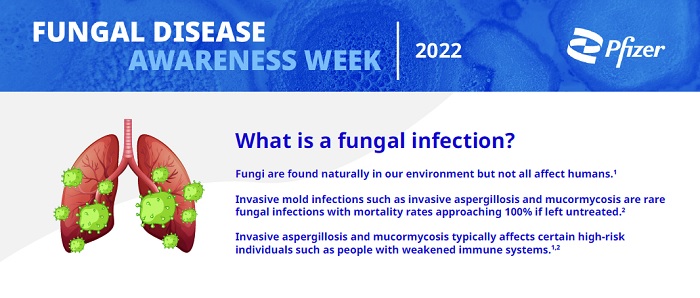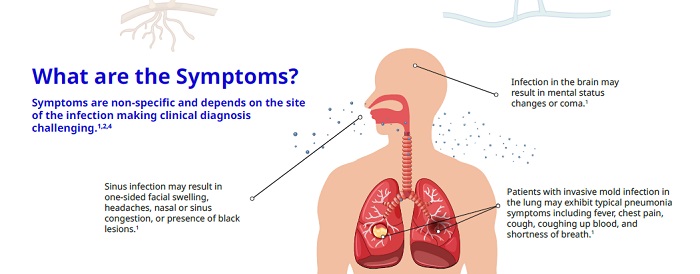Fungi are found naturally in our environment. There are many different types of fungi, with over 2 million species. However, about 600 fungi have caused diseases.
Invasive fungal infections typically manifest as a severe and aggressive form of the disease corresponding to high morbidity and mortality rates if left untreated.
Invasive fungal infections include invasive mold infections. Invasive mold infections are usually caused by Aspergillus spp but can also be caused by other rarer molds such as mucormycetes, known as invasive aspergillosis and mucormycosis, respectively.
These molds produce spores we encounter every day without getting ill. However, this may not be the case for people with compromised immune systems.

Can we also talk about the prevalence of this fungal disease?
Invasive aspergillosis is uncommon and occurs primarily in immunocompromised people. Estimated to affect over 300,000 patients worldwide annually, this disease is commonly seen in people with stem cell and other organ transplants, especially lung transplants, or in patients with haematological malignancies such as acute leukaemia.
Mucormycosis is rare and estimated to affect approximately 10,000 cases worldwide, barring India. If India is included, the numbers rise to 910,000 cases annually. Mucormycosis is increasingly reported in patients with uncontrolled diabetes, haematological malignancies, transplants, and high-dose corticosteroid therapy.

Why is this an issue?
Invasive mold infections are often neglected and dwarfs in terms of awareness versus other infectious diseases. Despite invasive aspergillosis and mucormycosis being relatively uncommon to other infectious diseases, invasive mold infections are often life-threatening. If left untreated, the mortality rates can reach 100%.
Diagnosis of invasive mold infections is challenging, leading to delays in optimum management, which are essential for favourable outcomes.
Recently, various parts of the world have reported superinfections of invasive aspergillosis and mucormycosis in patients with Covid-19, which are associated with increased mortality risk. COVID-19 likely increases the risk for fungal infections because it weakens the immune system or due to certain therapies used to treat Covid-19, such as steroids.
Jeopardizing the health and the wallet
The risk of developing the disease depends on each person’s overall health. Risk factors that make a person vulnerable to the disease include those having a weakened immune system, haematological malignancies such as acute leukaemia; patients undergoing chemotherapy or patients receiving high dose corticosteroids, transplant recipients and mucormycosis per se; poorly controlled diabetes mellitus in ketoacidosis is one of the major risk factors.
Invasive aspergillosis typically affects the lungs, but it can also spread to other parts of the body. Mucormycosis, on the other hand, typically occurs in the sinuses (cavities, or air-filled pockets, that are near the nose passage) or the lungs however it can spread to the brain and other organs as well.
Symptoms are non-specific, depending on the site of the infection; hence it poses a diagnostic challenge. Patients with invasive mold infection in the lungs may exhibit typical pneumonia symptoms, including fever, chest pain, cough, coughing up blood, and shortness of breath.
Sinus infection may cause pain, tenderness, swelling and pressure around the eyes, cheeks, nose or forehead, one-sided facial swelling, headaches, nasal or sinus congestion, or black lesions on the nasal bridge. Infection in the brain can cause mental status changes or coma in the late stage.
Those suffering from this infection are admitted into hospitals, often requiring a lengthy stay which imposes substantial healthcare costs. Not only that but the increase in healthcare costs will also be affected due to additional diagnostic and treatment interventions associated with the disease.

Is prevention better than cure for fungal disease?
It is nearly impossible to avoid exposure to fungal spores because fungi that cause invasive aspergillosis and mucormycosis are common in the environment. There are several preventive measures for people with weakened immune systems to lower the chances of developing these fatal diseases.
- Avoid activities that involve close contact with soil and dust, such as yard work or gardening. If you do these outdoor activities, wear shoes, long pants, and long-sleeved shirts
- Avoid dusty areas like construction or excavation sites.
- Ensure to keep your house dry and mold-free
- Avoid staying in a moldy home or even being there while it is being cleaned.
- Wear an N95 mask if you cannot limit exposure to these areas.
- Your doctor may prescribe medications to prevent these mold infections based on your risk factors











